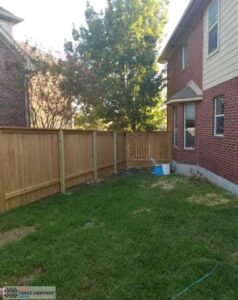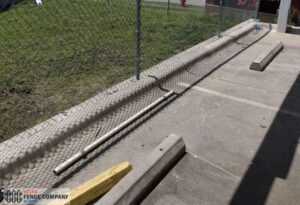School & Daycare Perimeter Fencing: Safety, Visibility, Access
TL;DR
For K-12 campuses and childcare centers, a secure perimeter fence must be more than just strong—it needs to support safety, visibility, and daily operations. The best school fencing is legible (visitors can intuitively understand entrances and pathways), visible (staff have clear sightlines through the fence), unclimbable (reduced footholds for added security), and serviceable (hardware that adjusts easily and posts designed to resist water damage). In Greater Austin, where soils alternate between expansive clay and hard limestone, these design considerations are critical for long-term durability.
That’s why transparent systems like ornamental steel and rigid welded-wire are often paired with purposeful gate zones, panic-grade egress hardware where required, and deep-set foundations engineered for Central Texas terrain. Equally important is operational planning—designing for morning arrivals, mid-day deliveries, after-school events, and emergency protocols ensures the fence works seamlessly with the flow of campus life. Documenting the full specifications—fence heights, panel apertures, gate hardware, and conduit paths—provides accountability and clarity for both contractors and administrators. Finally, commissioning the system with staff, not just installers, helps ensure everyone understands its function from day one. For expert design and installation that balances safety, compliance, and practicality, partner with Atlas Fence Company—the fence company Austin schools and childcare centers trust for reliable perimeter solutions.
Table of Contents
ToggleWhat Austin schools actually need from a fence (beyond “security”)

“Security” is the headline, but campuses run on predictability. A successful perimeter gives leadership control over where and how people move.
- Containment with clarity. A see-through edge lets staff instantly confirm where students, visitors, and vendors are relative to buildings and play areas.
- One obvious front door. Visitors should be funnelled toward a clearly marked, monitored gate—never tempted by side entries that “look open.”
- Egress that is obvious under stress. Gates serving egress routes must open quickly, reliably, and intuitively for students and staff.
- Durability that matches the schedule. Schools can’t shut down for repairs every semester. Foundations, coatings, and hardware need to survive heat, UV, storms, and expansive soils with minimal downtime.
- Service lanes that don’t collide with kids. Deliveries, grounds, and maintenance flows should sit on their own gate rhythm and away from arrival/ dismissal zones.
If you’re upgrading more than one edge, consider bundling layout, posts, gates, and operators during a single fence installation in Austin so hardware and finishes match across the campus.
Sightlines that work: supervision, CPTED, and the “readable” campus edge
Good supervision is a sightline problem. Staff need uninterrupted views across arrival approaches, queuing areas, and play yards.
- Transparency first. Open picket or rigid welded-wire panels preserve visibility while deterring climbing. Avoid solid walls except where truly necessary (acoustics, neighbors) and keep them short and strategic.
- No surprise “pockets.” Eliminate alcoves created by jogs, dumpsters, or tall plantings at corners. If you must screen a service yard, keep the rest of that run transparent to maintain continuous observation.
- Height vs. aperture. Taller isn’t always better if it introduces footholds. A correctly detailed 6–8 ft transparent system with tight apertures is more complex to scale than a heavy privacy panel with cross-rails on the public side.
- Readable edges. When families arrive, the fence should “explain” where to queue and where not to stand. A clean line of posts and panels—no patchwork—helps the edge feel managed, not improvised.
Choosing the right system: ornamental steel, welded-wire, and hybrid corridors
Each system solves slightly different problems. Many campuses opt for a hybrid approach, using ornamental steel at frontages and welded wire for long runs or athletic edges.
Ornamental steel (flat-top, vertical picket)
- Why schools like it: Clean lines, excellent visibility, minimal footholds, and a civic look that elevates the frontage.
- Design notes: Use flat-top profiles (no spear points) and picket spacing that deters head entrapment while preserving sightlines—powder-coat with high-durability finishes suited to our sun and heat.
Rigid welded-wire panels (school-grade)
- Why schools like it: Very tight apertures to defeat toe holds; excellent ball containment near courts; efficient for long, straight corridors.
- Design notes: Use robust brackets and galvanized, powder-coated panels. Where the public can interact with the fence, choose mesh apertures that resist climbing and tampering.
Chain link (selective use only)
- When it makes sense: Back-of-house or interior service partitions where appearance is less critical and budgets are tight.
- Design notes: Smaller mesh and top treatments that remove impalement hazards; limit fabric screens to short, justified runs to avoid blocking supervision.
Hybrids that feel intentional
Ornamental steel at the main frontage + visitor queue, welded-wire along long fields, and a short stretch of solid acoustic screen near loud roads—tied together by consistent posts/coatings so the perimeter reads as one system.
The arrival choreography: gate zones, flows, queuing, and signage

Morning arrival, late slips, mid-day vendor entry, and dismissal are different problems. Your gates must handle all of them without confusion.
- One monitored visitor gate. Bring visitors to a single, camera-covered, intercom-enabled gate near the admin. A second “after-hours” gate can exist, but it should still usher guests to the office entry.
- Dedicated service gates. Deliveries, grounds, and waste should not be mixed with student queues. Service gates get their own wider leaves and swing clear of pedestrian desire lines.
- Queuing geometry. Use fence lines, bollards, planters, or stripes to shape queues so they don’t spill into driveways.
- Hardware that forgives real life. Adjustable heavy-duty hinges, latch sets that can be re-aimed seasonally, and, where required, panic-grade egress devices. We fabricate and hang reliable gate assemblies through our gate installation service.
Play yards & early-learning areas: safety without sacrificing visibility.
Early-learning and elementary play yards need special attention.
- Sightlines to faces and hands. Transparent systems let teachers scan for behavior, injuries, and boundary issues.
- Openings & gaps sized for small bodies. Choose picket spacing or mesh apertures that prevent head and limb entrapment; maintain tight bottom tolerances to discourage crawl-throughs.
- Hardware out of reach. Latches and release devices should be out of a child’s reach but still accessible to staff in an emergency.
- Impact zones. Near ball play, welded-wire with tight apertures is often a better choice than open pickets.
- Shade & heat. Austin’s sun is no joke. Coordinate shade placement so it doesn’t create climb assists outside the fence, and specify coatings that resist chalking and color fade.
Hardening the perimeter without a fortress feel
Parents, neighbors, and boards want safety and a welcoming look.
- Flat-top, not spikes. Smooth profiles reduce hazard without compromising deterrence.
- Avoid horizontal “ladders.” Detail rails on the campus side where feasible, and keep the public side unclimbable.
- Selective opacity. If you need privacy along a street or neighbor, use short stretches of solid barrier and keep corner approaches transparent for surveillance.
- Branding as wayfinding. Campus ID at the visitor gate assures families they’re in the right place and signals a managed perimeter.
Posts, footings & finishes for Austin clay and limestone
Austin soils vary dramatically across a single campus. East-side expansive clays heave and shrink; west-side sites often hit limestone shelves at shallow depths.
- Drainage first. Set posts on compacted gravel beds to drain the socket; avoid trapping water against wood or steel.
- Crowned collars. Where posts meet grade, form a sloped concrete collar that sheds water away from the post. This small detail prevents rot in wood and corrosion in steel.
- Embedment strategy. Typical 30–36″ for yard perimeters, deeper for tall runs or wind exposure. On limestone, core-drill and set with non-shrink grout or epoxy for a rock-solid base.
- Coatings that work here. Start with galvanization, where applicable, and add a high-durability powder coat engineered for UV, heat, and chalk resistance.
- Hardware selection. Use hot-dip galvanized or compatible exterior-rated fasteners; through-bolt where you can. Keep mixed-metal stacks to a minimum.
Spec package & submittals: the drawings that prevent change orders
Paperwork done right keeps your project on schedule and under budget.
- Plan sheets. Show fence alignments, panel types, and gate locations with swing directions and clearances.
- Details. Include picket spacing or mesh aperture, post sizes and embedment, crowned collar detail, and bottom tolerances at slopes.
- Schedules. Gate hardware schedules (hinges, latches, exit devices, closers, operators), finish schedules, and signage locations.
- Low-voltage coordination. Conduit paths, power supplies for operators or electrified locks, and device mounting heights—all shown before the first hole is dug.
- Commissioning plan. A checklist for self-close/self-latch behavior, panic egress verification, camera/intercom alignment, and staff training.
Building on a live campus: phasing, safety, and communication
Perimeter work often occurs during school sessions.
- Zone it. Break the campus into manageable segments so students are never routed through active work.
- Maintain the chain of custody. Temporary fencing preserves the separation between construction and student spaces.
- Quiet hours & deliveries. Schedule noisy work and material drops outside arrival/dismissal windows; keep haul routes off parent queues.
- Stakeholder briefings. Give administrators and teachers a simple map that indicates what’s open, what’s closed, and for how long—and update it as phases change.
Lifecycle planning: inspection cadence, tune-ups, and refinish cycles

Great fences still need care.
- Quarterly visual checks. Look for movement at posts, hinge misalignment, and latch strikes drifting.
- Semi-annual tune-ups. Tighten through-bolts, re-aim latches, reset hinge tension, and check egress hardware function.
- Coating maintenance. Rinse dirt and de-icing residue after rare winter events; plan refinish intervals for high-sun exposures.
- After storms. Walk long runs for tree impact, loose brackets, or panel racking. For a deeper checklist, see our Storm Fence Checklist for Austin.
Budgeting and total cost of ownership in Central Texas
Your first-cost line item isn’t the only number that matters.
- Ornamental steel typically carries a higher upfront cost but offers civic aesthetics and excellent longevity on frontages.
- Rigid welded-wire is efficient for long corridors, athletic edges, and play yards where ball containment matters.
- Chain link is a targeted tool for service areas; keep it off frontages when appearance and community acceptance are priorities.
- Gates are the cost drivers. Plan for heavier frames, better hinges, and egress hardware where needed—they’re worth it over years of daily cycles.
- Standardize. Matching posts, coatings, and hardware reduces the need for spare parts and training time.
FAQs
Most K-12 perimeters run 6–8 ft, depending on exposure and adjacency. Daycare play yards commonly use 5–6 ft with tighter apertures and hardware mounted out of the child’s reach.
Use transparent systems at public edges, add short stretches of solid screening only where justified (noise or sensitive adjacency), and keep branding and signage clear at the main gate.
Where you need controlled access throughout the day, yes—but only if conduit paths, power supplies, and device locations are documented up front and installed by a coordinated team.
Start with stiffer posts, crowned collars, and steel gate frames. Choose adjustable hinges you can tune seasonally and latches with vertical/horizontal play.
Rigid welded-wire with tight apertures resists climb and contains balls better than open pickets, while keeping supervision sightlines crisp.
Plan Your Campus Perimeter
Ready to map your campus perimeter and gate plan? We’ll walk the site with facilities and admin, mark flows, and design a fence/gate package that’s safe, visible, and easy to operate. Take the first step toward a secure and well-planned perimeter. Request your free estimate today →
